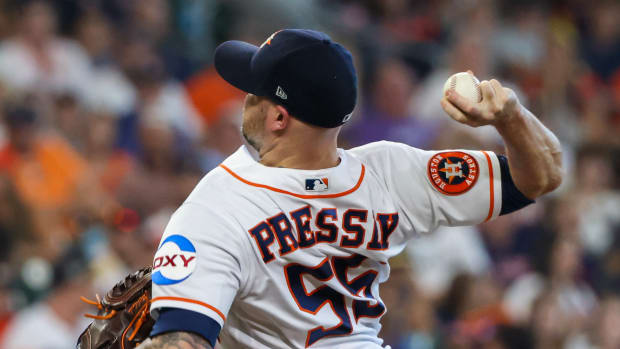Grading the Trevor Bauer Trade for the Indians, Reds and Padres
The trade market exploded Tuesday night with one of the weirdest, wildest blockbuster deadline deals in recent memory. Let’s grade the deal—headlined by three polarizing big league players—that sent the baseball world into a frenzy.
The Deal
Indians acquire: OF Yasiel Puig from Reds, OF Franmil Reyes from Padres, LHP prospect Logan Allen from Padres, INF/OF prospect Victor Nova, LHP prospect Scott Moss from Reds
Reds acquire: RHP Trevor Bauer from Indians
Padres acquire: OF prospect Taylor Trammell from Reds
Grading Cleveland’s Side of the Deal
Think of it this way: The Indians have arguably the deepest starting rotation in baseball but one of the worst starting outfields, so they traded a strength to address a weakness.
Before the trade, Cleveland’s starting rotation looked something like this:
1) Bauer (9-8, 3.79 ERA, 125 ERA+)
2) RHP Mike Clevenger (5-2, 3.28 ERA, 145 ERA+)
3) RHP Shane Bieber (10-4, 3.40 ERA, 138 ERA+)
4) RHP Adam Plukto (3-2, 4.83 ERA, 99 ERA+)
5) RHP Zack Plesac (5-3, 3.10 ERA, 154 ERA+)
* RHP Danny Salazar, who will be activated from the injured list Wednesday and make his 2019 debut on Thursday.
Injured List: RHP Corey Kluber, RHP Carlos Carrasco
With Bauer gone, bump each pitcher up a slot with Salazar sliding into the No. 5 role to see what the immediate rotation will look like following the trade. According to ERA+, the only below-league-average pitcher in that group is Plutko, and he’s below that mark by one percentage point.
Salazar will be replacing Bauer in the rotation as a starter-opener hybrid (he’s limited to about 70 pitches) until his arm has been stretched out to about full strength. The 29-year-old hasn’t pitched since the 2017 ALDS, but when healthy he’s been one of the better starting pitchers in the game. His lifetime 10.51 strikeouts per nine ranks first in franchise history among pitchers with at least 500 innings. Two-time Cy Young Award winner Kluber is also getting closer to returning and Carrasco, who was diagnosed with leukemia a few months ago, is hoping to pitch again this season, too.
Even without Bauer, Cleveland’s rotation should be just fine. At the same time, the Indians needed help both in their lineup and in the outfield. Outfield production was an issue for them going into the season, before third baseman Jose Ramirez and second baseman Jason Kipnis slumped for most of the first half. Entering play Tuesday, the only contending team with a worse outfield OPS was the Giants.
Enter Puig and Reyes, two righthanded power hitters who’ve combined for 49 home runs this season. Everyone knows about Puig, the Wild Horse, a fan favorite whose antics have at times irritated his teammates and coaching staff. He’s an ultra-competitor who’s capable of carrying teams for weeks.
But Reyes, however, could be the more threatening bat of the two. He’s 6’ 5” and 275 pounds, and ranks 15th in the majors with an average exit velocity of 92.3 mph. His defense is suspect, but the Indians could simply slot him in as their designated hitter on most days. The Franimal is what they called him in San Diego.
Quick aside on Reyes: I covered him last summer when the Padres played the Cubs at Wrigley Field and saw him demolish a 477-foot home run off Jon Lester.
After the game, I asked him if his blast was furthest he’s ever hit, at any level. “No,” Reyes said. Follow-up: “Was it even close?” Without hesitation, he said: “No.”
Talk about intimidation.
While Puig hits free agency at the end of the year, the 24-year-old Reyes is under team control until 2025. Puig can help them win this season—they’re three games behind the Twins in the AL Central and hold the first wild-card spot—while Reyes is an investment for years to come.
Grade: A
Grading Cincinnati’s side of the deal:
This move is a bit more puzzling. Like the Mets, the Reds aren’t likely to make the playoffs this season but acquired one of the marquee starting pitchers on the market and gave up prospects to get him. Bauer is a great pitcher and adding him to what is already one of the best starting rotations in baseball (their 3.83 starters ERA ranked fifth in MLB entering Tuesday) is sure to disrupt the NL Central race, even if Cincinnati isn’t contending. Making this trade more confusing is that the Reds traded minor league outfielder Trammell, their No. 1 prospect (30th overall) according to MLB Pipeline. That was the price to pay to reel in Bauer, who isn't a free agent until after the 2020 season.
Grade: C+ (If Cincinnati decides to flip Bauer in a trade for a stockpile of prospects before the deadline, this grade could improve drastically. But a trade isn't likely, according to USA Today's Bob Nightengale)
Grading San Diego’s side of the deal:
Trammell is a dynamic athlete who’s struggled this year in Double A, but he’s got all the tools to be a flashy franchise centerfielder in San Diego. The Padres had a lot of corner outfield depth on their roster, and considering they are likely a year away from contention, this was a good time to get a blue-chip prospect who should be major-league ready just in time for San Diego to be relevant again in the NL West.
Grade: B+




































